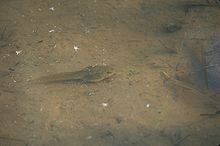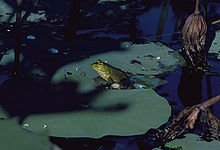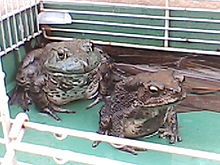- Bullfrog
-
For other uses, see Bullfrog (disambiguation).
American Bullfrog 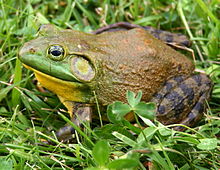
adult male Conservation status Scientific classification Kingdom: Animalia Phylum: Chordata Class: Amphibia Order: Anura Family: Ranidae Genus: Rana Species: R. catesbeiana Binomial name Rana catesbeiana
Shaw, 1802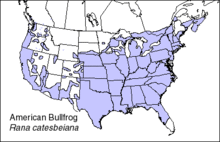
Bullfrog range Synonyms Lithobates catesbeianus Dubois, 2006
The American bullfrog (Rana catesbeiana)[1][2][3], often simply known as the bullfrog in Canada and the United States, is an aquatic frog, a member of the family Ranidae, or “true frogs”, native to much of North America.[4] This is a frog of larger, permanent water bodies, swamps, ponds, and lakes, where it is usually found along the water's edge.[5] On rainy nights, bullfrogs, along with many other amphibians, travel overland, and may be seen in numbers on country roads.
American bullfrogs live longer in warm weather. They have been widely introduced across North America (see range map). The original, naturally determined range did not include the far western regions where it is found today.[6]
Contents
Description
They grow on average to be about 3.6 to 6 in (9.1 to 15 cm) in body length (although there are records of some up to 8.0 in (20 cm)), legs add another 7 to 10 in (18 to 25 cm) to length. The adult bullfrog skeleton is representative of tetrapod vertebrates, comprising an axial skeleton (skull and vertebrae) and an appendicular skeleton (pectoral girdle and forelimbs, pelvic girdle and hindlimbs). Ranids, however, lack ribs. The pronounced pair of dorsal humps in the back of ranid frogs are the ends of the pelvic ilia, homologues of the human hips.
The bullfrog skull is highly fenestrated. The orbits open ventrally through the roof of the mouth to accommodate eye retraction during locomotion and swallowing. The skull bears a continuous row of tiny teeth on the maxilla and premaxilla and a pair of small vomerine teeth on the palate. The mandible is toothless.
The bullfrog nervous system consists of a brain, spinal cord, and peripheral nerves, including cranial, spinal, and sympathetic nerves serving organs, such as the heart, gastrointestinal tract, kidneys, and gonads.
Females have eardrums (tympana) the same size as their eyes. Males' eardrums are larger.
Ecology and behavior
Respiration
Ranid frogs absorb oxygen and eliminate carbon dioxide through their moist skin, the lining of the mouth, and the lungs. When in the air, as opposed to underwater, frogs continuously elevate and lower the floor of the mouth, which serves to ventilate the mouth, or buccal cavity, and exchange gases through the richly vascularized lining of the mouth. Periodically, the regular rhythmic pumping of the floor of the mouth is interrupted by a deeper lowering of the throat, at the extreme of which, the glottis opens and the throat muscles contract vigorously to force air from the mouth into the lungs—the nostrils are closed off. This lung ventilation may be performed several times, after which the shallow buccal ventilation resumes.[7] Lacking ribs, frogs must supply the pressure to force air into their lungs, whereas mammals can enlarge the cavity surrounded by the rigid rib cage and allow the atmosphere to supply the pressure.
Reproduction
Fertilization is external in ranid frogs. In the mating grasp, or amplexus, the male rides on top of the female, grasping her with his forelimbs posterior to her forelimbs. The female bullfrog deposits her eggs in the water and the male simultaneously releases sperm.
Breeding begins in late spring or early summer. Males defend and call from territories, attracting females into a territory to mate. The call is reminiscent of the roar of a bull, hence the frog's common name. A female may produce up to 20,000 eggs in one clutch.[6]
Growth and development
Eggs hatch in three to five days. Time to metamorphosis ranges from a few months in the southern to three years in the northern parts of the geographic range.[6] Maximum lifespan in the wild is estimated at eight to 10 years, but one captive lived almost 16 years.[6]
Feeding
A juvenile with a small, grey, oval-shaped area on top of the head, the parietal eye
Stomach content studies going back to 1913 suggest the bullfrog preys on any animal it can overpower and stuff down its throat. Bullfrog stomachs have been found to contain rodents, small turtles, snakes, frogs (including bullfrogs), birds, and a bat, as well as the many invertebrates, such as insects, which are the usual food of ranid frogs.[8] These studies furthermore reveal the bullfrog's diet to be unique among North American Rana in the inclusion of large percentages of aquatic animals, e.g., fish, tadpoles, planorbid snails, and dytiscid beetles. The specialized ability of bullfrogs to capture submerged and large, strong prey comprises a pronounced biting motor pattern that follows up on the initial and typical ranid tongue strike.[8] Adaptation to target image displacement due to light refraction at the water-air interface consists of the bullfrog's application of tongue surface comparatively posterior to the perceived location of the prey target.[8] The comparative ability of bullfrogs to capture submerged prey, compared to that of the green frog, leopard frog, and wood frog (R. clamitans, R. pipiens, R. sylvatica, respectively) was also demonstrated in laboratory experiments.
Prey motion elicits feeding behavior. First, if necessary, the frog performs a single, orienting bodily rotation ending with the frog aimed towards the prey, followed by approaching leaps, if necessary. Once within striking distance, the bullfrog emits its feeding strike, which consists of a ballistic lunge (eyes closed as during all leaps) that ends with the mouth opening, extension of the fleshy and mucous-coated tongue upon the prey, often engulfing it, while the jaws continue their forward travel to close (bite) in close proximity to the prey's original location, just as the tongue is retracted back into the mouth, prey attached. Large prey that do not travel entirely into the mouth are literally stuffed in with the forearms. In laboratory observations, bullfrogs taking mice usually dove underwater with prey in mouth, apparently with the advantageous result of altering the mouse's defense from counterattack to struggling for air.[8] The tiny teeth of bullfrogs are useful only in grasping. Asphyxiation is the most likely cause of death of endothermic (warm-blooded) bullfrog prey.
Human use
While occasionally kept as pets, the American bullfrog provides a food source, especially in the Southern United States and in some areas of the Midwestern United States. In a few locations, they are commercially cultured in ponds, but the traditional way of hunting them is to paddle or pole silently by canoe or flatboat in streams or swamps at night; when the frog call is heard, a light is shone on the frog to temporarily inhibit it. The frog will not jump into deeper water as long as movement is slow and steady. When close enough, the frog is gigged and brought into the boat. In some states, breaking the skin while catching them is illegal, and either grasping gigs or hand capture are used. The only parts eaten are the rear legs, which resemble small chicken drumsticks and, sometimes, the backs, which are usually fried.
The American bullfrog is also used as a specimen for dissection in many schools across the world.
The American bullfrog is the state amphibian of Iowa, Missouri, and Oklahoma.
The American bullfrog has been introduced to many countries in the world, such as South Korea, Western Europe, Brazil, Colombia, and Australia, where it has become a nuisance to those countries' natural ecology because of its appetite.
The American bullfrog has been widely introduced to most western states, and is now very common there, especially in California, and poses a serious threat to native species, such as the California red-legged frog because bullfrogs are aggressive and will eat anything smaller than themselves. They are considered a factor of the red-legged frogs' decline.
Footnotes
- ^ Hillis, D. M. 2007. Constraints in naming parts of the Tree of Life. Molecular Phylogenetics and Evolution 42:331–338.
- ^ Hillis, D. M., and T. P. Wilcox. 2005. Phylogeny of the New World True Frogs (Rana. Molecular Phylogenetics and Evolution 34:299–314.
- ^ "Rana catesbeiana". Integrated Taxonomic Information System. http://www.itis.gov/servlet/SingleRpt/SingleRpt?search_topic=TSN&search_value=173441. Retrieved 6 February 2006.
- ^ Hillis & Wilcox (2005), Pauly et al. (2009)
- ^ Conant, 1958
- ^ a b c d Casper, G. S. and Hendricks, R. (2005) Amphibian Declines: The Conservation Status of United States Species, M. Lannoo, ed. University of California Press.
- ^ Noble, G. K. (1931) The Biology of the Amphibia. McGraw-Hill.
- ^ a b c d Cardini 1974
References
- Cardini, F. (1974) Specializations of the Feeding Response of the Bullfrog, Rana catesbeiana, for the Capture of Prey Submerged in Water. M.S. Thesis, U. of Massachusetts, Amherst, MA
- Conant, R. (1958) A Field Guide to Reptiles and Amphibians. Houghton Mifflin Co., Boston.
- Hillis, D.M. & Wilcox, T.P. (2005): Phylogeny of the New World true frogs (Rana). Mol. Phylogenet. Evol. 34(2): 299–314. doi:10.1016/j.ympev.2004.10.007 PDF fulltext.
- Hillis, D. M. (2007) Constraints in naming parts of the Tree of Life. Mol. Phylogenet. Evol. 42: 331–338.
- Santos-Barrera, G. et al. (2004). Rana catesbiana. 2006. IUCN Red List of Threatened Species. IUCN 2006. www.iucnredlist.org. Retrieved on 12 May 2006. Database entry includes a range map and justification for why this species is of least concern.
- Pauly, Greg B., Hillis, David M. & Cannatella, David C. (2009): Taxonomic freedom and the role of official lists of species names. Herpetologica 65: 115–128. PDF fulltext
External links
- Herps of Texas: Rana catesbeiana
- British Columbia Frog Watch Program: Bull Frog Fact Sheet
- Bullfrog at allaboutfrogs.com
- Bullfrog recordings
- American Bullfrog (Lithobates catesbeianus), Ontario Nature
- Species Profile - Bullfrog (Rana catesbeiana), National Invasive Species Information Center, United States National Agricultural Library. Lists general information and resources for Bullfrog.
Categories:- IUCN Red List least concern species
- Rana
- Amphibians of the United States
- Amphibians of Canada
- Fauna of Delaware and Maryland
- Invasive animal species
- Pet amphibians
- Animals described in 1802
Wikimedia Foundation. 2010.



